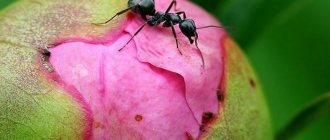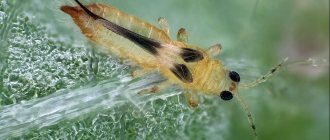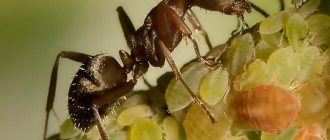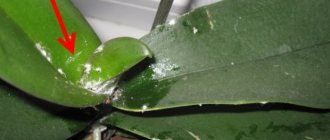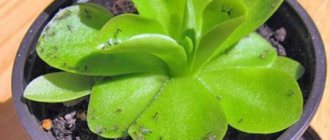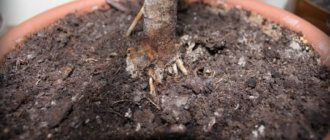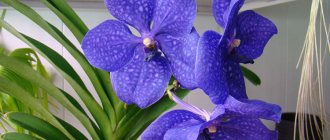A blooming orchid brings true pleasure, amazing the owner :
- Variety of color shades;
- The splendor of rather large flowers;
- And the duration of flowering.
And it seems that proper care is being carried out, favorable conditions have been created, but suddenly some small midges appear , spoiling the whole picture of splendor.
If urgent measures are not taken, then, in addition to the inconvenience, they also seriously harm the plant and can even destroy it.
Causes of pests on orchids
Insects can appear on plants for several reasons:
- Contaminated soil. If the soil mixture was prepared incorrectly and was not disinfected before use, eggs or larvae could remain in it. If you transplant an orchid into it and then water it, conditions favorable for the development of pests will be created. The midges will begin to actively reproduce.
- Excessive watering. Midges can enter a house through a window, but unless they find suitable conditions, they will not stay indoors. If there are plants inside with constantly moist soil, insects will take up residence there.
Insects leave noticeable damage on orchid leaves
- Using moss. As a rule, gardeners use it to slow down the evaporation of moisture from the soil. If parts that have begun to decompose are not promptly removed, pests appear.
- The use of natural fertilizers: shells, tea leaves, coffee grounds. Decaying organic matter attracts insects.
Important! To choose the right remedy for midges on plants, you need to identify and eliminate the cause of their appearance.
People's Councils
At the first symptoms of the appearance of harmful midges, you should urgently begin to eliminate it. The main methods that show a strong positive effect are:
- replacing old, damaged soil with new one;
- use of special chemicals;
- traditional methods;
- installation of various traps.
We invite you to familiarize yourself with Grafting grapes: the main methods and optimal time. Each method has both strengths and weaknesses, which we will discuss further.
A simple and effective way to get rid of insects parasitizing on a flower. It is recommended to keep the new primer in the refrigerator for several days before replacing it. Low temperatures will kill parasite larvae if they are present. It is also recommended to remove all leaves that have fallen to the ground from the pot, since their rotting attracts insects from the outside to the healthy flower.
Drugs
The most effective way to combat any pests, leaving no chance for parasites. The only disadvantage due to which the use of chemicals is not welcomed by many gardeners is their toxicity.
To do this, they use sticky tapes that are hung next to the plants - for some reason, midges prefer to sit on yellow tape. Yellow saucers with a sweet liquid or special granules for flies also catch insects.
Some orchid growers grow carnivorous plants next to their orchids - Venus flytrap, sundew or butterwort, while others plant a small onion-garlic “vegetable garden” in small containers next to their collection of exotic plants.
When there are midges in orchids, but there is no way to use chemicals, folk remedies are used. You can get rid of parasites as follows:
- Citrus fruit peels, lavender or garlic will help get rid of most insects. They are placed next to the plant or made into decoctions that are sprayed on the bushes. Orange peels against midges in orchids.
- Most pests can be removed with a light pink solution of potassium permanganate. The plantings are watered with the preparation until the parasites are completely destroyed.
- To prevent pests from appearing, make phalaenopsis the main crop planted on the windowsills of your apartment. This species is not attacked by white and dark flies, but it has enemies such as spider mites.
- Replant the flower in new, safe, fully sterilized soil. This method is effective against sciarids.
- Pests are removed by washing the bush in the shower. This procedure is carried out every 3 or 4 days.
- It is recommended to sprinkle the soil with mustard (powder). Every 6-7 days you need to pour a fresh portion of the powder.
- River sand baked in the oven helps repel midges. It is poured on top of the soil. If after 4-5 days there are still pests on the flowers, the procedure is repeated.
- Sticky sticks and traps are effective not only against fruit flies - they are also used to attract mosquitoes, whiteflies and scale insects.
Some gardeners say that folk methods will tell you how to get rid of midges on orchids.
These include:
- Garlic infusion. To do this, you need to finely chop a few cloves of garlic and pour boiling water over them. After standing for 5 hours, the leaf plates of the flower and the soil should be treated with the infusion.
- A clove of garlic. One slice should be buried in the substrate. After some time, you will notice that the midges in the orchids have disappeared as suddenly as they appeared.
- Bait traps. There are adhesive tapes on sale today that should be placed next to the flower. It must be said that this method has no effect on the larvae, so it is ineffective.
- Wood ash. Ash poured on top of the substrate will allow you to forget about midges forever, significantly reduce the acidity of the soil mixture, and also fertilize the flower well.
- Soap solution. You need to take a teaspoon of liquid soap and dilute it in a glass of water, and then rinse the flower leaves well on all sides with this solution.
Types of midges
Midges in indoor flowers - how to get rid of them at home
You can understand how to get rid of midges in orchids only by first determining their type. It is important to choose an effective remedy that will not harm the plant. Most often, 4 types of insects live in flowers.
Thrips
Small - up to 2.5 mm - dark-colored midges with an elongated body and wings folded on the back. It is not easy to detect them, since they are active in the dark and hide in the soil in the sun. Dry soil is attractive to pests of this type, so you need to water the flower regularly.
A sign of their presence can be dark spots on the leaves. They reproduce quickly and lay eggs on leaves. Adults damage all parts of the plant, sucking out the juice, while the larvae damage only the leaves.
Whiteflies
You can learn about the appearance of white small flies by carefully examining the plant (you can see yellow marks on it) and the soil where the eggs or light-colored larvae will be located. If you touch a flower, butterflies will scatter throughout the room.
Whiteflies live on the undersides of leaves, making them difficult to detect
The larvae feed on leaf sap, so the leaves of orchids affected by whiteflies begin to dry out and turn yellow.
Sciarides
They are black mosquitoes, not exceeding 5 mm in size. They are most active in autumn or spring.
Adults (this is their second name) do not harm phalaenopsis, but lay eggs in the ground. The hatched larvae feed on the roots of the plant. The affected areas of the root system begin to rot, fungus and infections penetrate inside, due to which the orchid may die.
Drosophila
Fruit midges do not eat the plant; they feed on rotting organic matter. As a rule, they appear in groups, hovering over areas of interest to them. They pose a danger because they reproduce at high speed. If you do not remove insects, they will quickly fill the apartment.
What to do?
To understand how to remove insects and what needs to be treated, you need to determine what type of pest attacked your plant. But there are general rules for destroying midges, suitable for all types of attackers:
- Place the affected flower in an isolated place for at least a month.
- Rinse off all visible midges with warm water. This can be done with a damp cloth or with a powerful spray. This procedure will help get rid of most of the midges.
- Trim off all affected areas of the orchid. Don't forget to treat the cut areas with wood ash.
The flower can be treated with both folk and pharmaceutical chemicals. But experienced gardeners recommend resorting to the help of the latter only in very extreme cases. Folk remedies include:
- soap solution (pour one teaspoon of liquid soap into 0.2 liters of water);
- garlic tincture (pour boiling water over five crushed cloves of garlic) (it is also recommended to simply place a clove of garlic in the soil);
- a solution of olive or grape oil (pour a tablespoon of oil into half a liter of water);
- wood ash, which not only reduces the acidity level of the soil, but also feeds it.
TIP: All solutions cover the leaf blade with a dense layer and interfere with the photosynthesis process, so do not forget to wash the drug off the plant in time.
As for insecticides, each type of attacking insect uses its own type of preparation:
- It is better to fight whiteflies with a solution of laundry soap. But if this remedy does not help, use “Aktellik”, “Aktar”, “Bazudin”, “Fury” (the plant must be sprayed with these products every five days). A vacuum cleaner will also help you say goodbye to the majority of adult whiteflies. Scare away the midges, wait until they start flying over the orchid and collect them with a vacuum cleaner.
- Fitoverm or Actellik will help you in the fight against thrips. (Process no more than three times with a time interval of ten days). After the destruction of thrips, it will be necessary to cultivate the soil monthly to prevent the reappearance of these midges.
- Sciarides are easy to defeat without even resorting to chemical solutions. All you need to do is install adhesive tape. Of course, it wouldn’t hurt to treat the soil with an insecticide. (“Raptor”, “Dichlorvos”, “Raid”). It wouldn’t hurt to treat the surface on which the pot with the orchid is located. After using many aerosol insecticides, it is necessary to ventilate the room after a half-hour period.
- For fruit flies, the main blow will be hunger strike. This can be achieved by removing all leftover food from the house, especially rotten vegetables and fruits. Always treat not only the plant itself, but also the soil in which it grows.
Remember that only the correct use of products will help cure an orchid. If you use drugs not according to the instructions, this will lead to even greater infection of the plant or its complete destruction.
Midges in orchids: how to get rid of them at home
Mealybug on an orchid: how to get rid of pests and treatments
If there are midges in an orchid, what to do first:
- Place the pot with the infected plant in quarantine for a month, that is, place it separately from other flowers.
- Place the flower under a gentle stream of warm water to wash away larvae, eggs and adults.
- Inspect the soil, stems and leaves, remove any remaining eggs and larvae with a damp cloth.
- Cut off dead and damaged parts of the plant, dust the cut areas with ash or crushed coal.
To remove pests from the roots, the plant is thoroughly washed with warm water.
Important! If the soil is heavily infested with pests, it is necessary to replant the orchid, thoroughly washing the roots.
Traditional methods
What to do if midges appear in the ground in orchids:
- Treat with soapy water. 1 tbsp. l. soap (preferably without dyes and other additives) is diluted in a glass of water. Moisten a cotton pad with the composition and gently wipe all parts of the plant for a week. After a break of several days, another 2-3 treatment cycles are repeated. When the insects disappear, wait a month, after which they wipe the flower once to prevent the reappearance of midges.
- Use garlic infusion. The cleaned head is crushed, poured Art. boiling water The liquid is used in the same way as a soap solution.
- Prepare an apple cider vinegar trap. The liquid is poured into a small jar, mixed with a couple of drops of dishwashing gel, and closed with a plastic lid with small holes made in it. The prepared container is placed next to the flower pot. Midges (fruit flies and sciarids), sensing the smell, will fly inside and die, since they will not be able to get out of the trap.
- Place citrus peels or garlic cloves around the plant. This folk method is based on the fact that strong odors repel insects.
- Prepare a weak solution of potassium permanganate and pour it over the soil. The disinfectant liquid will destroy the eggs and larvae.
- Sprinkle the soil with mustard powder. Repeat the procedure once a week until all midges disappear.
Spraying with garlic infusion is a plant-safe way to remove pests
Chemicals
Getting rid of insects using potent drugs is recommended in extreme cases when other methods have not helped.
The most difficult thing to deal with are sciarids. You will need to use several products in combination: the above-ground parts of the plant are treated with “Raid”, “Raptor” or “Neo Dichlorvos”, for the soil use “Bazudin” or “Grom-2”. Pests can remain not only in the pot, but also on the surfaces around it, so you need to wipe the windowsill with a disinfectant.
Actillicom is suitable for killing thrips. The infected plant is treated with this drug three times over a period of 10 days.
“Actellik” also effectively copes with whiteflies. They are also removed using insecticides “Sherpa” or “Fury”. To get rid of eggs and larvae, the soil is spilled with water.
How to get rid of it at home using biological methods
If midges appear in orchids, you can get rid of them using home remedies:
- Vacuum cleaner. It will help collect whiteflies. When you touch the phalaenopsis, the butterflies immediately fly up, disturbed. You can take advantage of this behavioral feature of theirs. You need to turn on the device in advance and point the end of the suction tube (it is better to remove the nozzle) just above the plant. Touch the orchid and the whiteflies will fly up and be sucked in. It will not be possible to collect all the midges at once; you need to repeat the operation several times, taking breaks.
- Fly tape. A ribbon hung near an infested plant will collect most of the adults.
- River sand. It is pre-calcined in the oven and then poured in a thin layer onto the ground. Monitor the condition of the plant: after a few days all the midges should disappear, and if this does not happen, the procedure is repeated.
- Soil washing. Since the most difficult thing is to remove not the adults, but the larvae, you need to thoroughly wash the soil every 4 days.
Note! If there are fruit flies in the house and flower pot, you need to fight them differently. You should throw away the remains of moss, tea leaves and other natural fertilizers, if they were used, and reduce the frequency of watering. Inspect the room, remove all food that attracts fruit flies (fruits, vegetables).
To get rid of fruit flies, all moss from the ground must be removed
Chemicals
Radical measures have to be taken when the substrate is already swarming with larvae; it is enough to lift its top layer 1 cm thick to detect them. Unfortunately, many chemicals are toxic and their use in residential areas is undesirable. It is advisable to move orchids affected by midges to a glazed balcony or veranda and spray there.
In enclosed spaces, treatment with the drugs Largon, Mikromit, Difluorobenzuron is allowed, which can destroy adults and larvae; Intavir and Carbofuran are considered stronger. Teflubenzuron affects the life cycle of sciarids and inhibits the process of transformation of larvae into adults, thus preventing an increase in the size of the colony.
Flower growers speak well of the granular product Grom-2, which is scattered on the surface of the substrate and lightly mixed with the top layer. Its consumption rate per 1 sq. m area is only 1-1.5 g, and it is effective until the granules are completely dissolved within 14 days.
Bayer products are considered harmless to humans, which are used both to prevent the appearance of sciarid larvae and to get rid of adult insects. When using the drugs Regent and Regent-800, you should carefully calculate the dosage. If the standard recommended solution is 1 g in 10 liters of water, then for orchids this norm is reduced by at least half. Finally, proven methods of combating house flies are used - Dichlorvos, Raptor sprays, and against larvae - Fly eater.
Prevention of infection
Whitefly on indoor plants - how to deal with it at home
To prevent insects from starting again, you should follow some rules:
- Sprinkle the soil purchased for indoor plants with plenty of water and then place it in the freezer for several days. During this time, the larvae, if they are present in the soil mixture, will die.
- Do not immediately place a purchased new flower in a room where others are located, but place it in a separate room. If after a month there are no pests on it, you can move it to the others. However, it is not recommended to keep the entire collection on one windowsill.
- Install mosquito nets on the windows to prevent insects from entering the house from the street.
- Keep the room where the orchid is kept clean and promptly throw away spoiled fruits and vegetables.
- New pots, before transplanting the plant into them, should be disinfected: pour boiling water over them or rinse with a manganese solution.
Preventive measures
Sometimes gardeners, not knowing the rules for caring for orchids, create an environment favorable for the reproduction of insects on their own. Some of them water the flower frequently and try to give it a large amount of liquid. Others, as mentioned earlier, place decorative moss on top of the soil.
Many housewives try to fertilize the flower with a variety of foods, believing that this will help make it healthier and more lush. There is no need to believe various myths; it is better to read reliable information about caring for the plant and do everything to ensure that it is strong and healthy.
It is important not to leave fruits or other products near the plants, because because of this, midges fly in from the street and lay larvae directly on the plant
The plant sometimes (several days) needs to be in completely dried soil.
There is no need to water it too often, it is important to follow the regime. It is worth maintaining a normal level of moisture in the room. You can place a peel of citrus fruit or a branch of lavender next to the pot. These odors can repel these insects. Midges can fly in from other rooms where food remains remain
It's better to take out the trash more often.
Before planting the orchid, it is worth placing the substrate in a cold place for 2-4 days. It's better to put it in the freezer. This will help kill insects if their larvae are still present in the soil. It is worth treating the sheet plates with a soap solution and also wiping them with a wet sponge.
But you also don’t need to do anything without understanding exactly what insects have settled in the orchid. If you fight midges incorrectly, you can only make the flower worse and lower its immunity.
Getting rid of these pests isn't too difficult, so don't panic. The fight may not be quick, but it is effective. Before using any product, you must read the instructions. Before fertilizing a plant, you should consult with professionals or study information on the Internet. Incorrectly selected fertilizers and poor care are what can provoke the appearance of midges, which will ruin the life of the gardener. It is better to prevent the occurrence of parasites than to treat the plant for a long time. If you take care of a flower, it will delight the owner for a long time.
To learn how to get rid of midges in orchids, see the following video.
Further care
Once the pests are eliminated, it is important to care for the orchid properly. The most important thing is to follow the watering regime: twice a week in the warm season, once in the cold season.
Note! If the soil is still damp, there is no need to water it. The top layer of soil should be dry for at least 2 days beforehand.
It is undesirable to use food waste (for example, tea leaves) as fertilizer. These substances will not provide the plant with everything it needs, but will attract pests. If there is a need for feeding, you should use special ready-made compounds for orchids.
Dying leaves are removed before they begin to rot, becoming food for midges.
Leaves that have turned yellow and have begun to die should be removed.
Periodically, as a preventive measure, it is recommended to wipe the phalaenopsis leaves with a soap solution. It forms a coating that protects the above-ground parts of plants from being eaten by pests. You can also sprinkle the soil with ash or sand, this will prevent insects from penetrating into the soil.
Midges can destroy an orchid, so you need to get rid of them immediately. The listed methods will help cope with the problem, and preventive measures will prevent the reappearance of insects.
What are they and why are they dangerous?
Insects that have taken a fancy to a flower pot are an unpleasant sight.
In addition, small animals can significantly damage the orchid, deform its parts, and also lead to death. Watching something beautiful die is always sad, so “neighbors” noticed in time are subject to immediate eviction. However, emergency measures to save the flower will have the desired effect only if the species of the midge is determined.
Sciarides
These pests are known as fungus gnats. Adults, reaching a size of no more than 0.5 cm, are black in color. They fly around the plant without causing significant harm to it. However, sciarids should not be considered safe. These insects choose a moist environment for breeding. If there is dampness in the pot, then there is every chance that fungus gnats will find waterlogged soil or peat an ideal environment for laying eggs.
The hatched larvae are the main destructive factor. The root system of orchids often serves as food, and its numerous damages, combined with excess moisture, lead to consequences in the form of rotting. In addition, there is a high probability of the plant being damaged by a fungal infection.
Whiteflies
Inconspicuous at first glance, but quite dangerous insects, start sounding the alarm and arming yourself with insecticides. White-winged little moths are secretive creatures. Usually they are discovered by chance by touching the plant: the disturbed midges immediately take off.
Future offspring of butterflies are laid both on leaves and on stems under a layer of bark. The feeding process of a nested colony is accompanied by yellowing, drying and death of both individual parts and the entire plant.
Thrips
Unlike the previously mentioned parasites, this species prefers conditions close to drought. Thrips are a tiny life form. The average size of adult individuals ranges from 2.5 mm. The appearance of midges resembles dark sticks with a pair of wings folded on the back. At the same time, insects do not fly and are nocturnal.
They feed on the tissues of flowers and lay eggs there. The first sign of the invasion of these pests is a scattering of dark spots on the leaf blades, as well as the presence of a silvery coating on them.
Fruit flies
Favorite insects of scientific researchers and experimenters are Drosophila, or fruit flies. They themselves are not parasites and do not harm indoor plants. Nevertheless, the appearance of fruit flies should be considered as a signal that a mistake has been made in caring for orchids.
Fruit flies are attracted to rot and fermentation. Often such processes can be triggered by high humidity conditions or the use of tea leaves, vegetable and fruit peelings as organic fertilizers.
Dampness and mold
Fungus bugs are not the most common pest of indoor plants. They are often confused with fruit flies (Drosophila), although our mosquitoes are darker in color. While fruit flies fly near fruits and rotten foods, sciarids appear near wet soil, sewers and drains.
Fungus gnats are attracted to CO2 (carbon dioxide), which is why they fly straight into your face.
Adults of these midges are 1-2 millimeters in length, thin and similar to very small mosquitoes. These tiny black insects seem harmless because they are just flying around the plant.
Mold in the substrate
But while adult insects sit on the leaves of the Orchid, without harming it, their larvae feed on juices from the thin root hairs of the flower. This leads to yellowing of the leaves and weakening of the plant. They can also damage the plant's fragile roots or stems, leaving it vulnerable to rot and infection.
The easiest way to avoid these midges is to water your Orchid properly. It is overwatering and poor drainage that promotes fungi, mold spores and rot that attracts fungus gnats.
Mechanical methods of protection
Mechanical methods of protection can combat mainly sedentary flying midges, for example, the white moth.
Products with specific repellent odors also help prevent the spread of midge colonies.
Traps and sticky tapes
In the fight against midges, it is worth paying attention to the color of the catching devices:
- The whitefly moth is attracted to the yellow tint, so a simple sheet of cardboard coated with a sticky substance is suitable as a homemade trap;
- thrips prefer blue, so it is better to use sticky tapes for them in this range; flower growers recommend placing a blue container (for example, a saucer) filled with water near the orchid.
Repellent odors
Most midges cannot tolerate the smell of ethers. Citrus fruits have repellent properties, the peel of which can be buried in the top layer of soil. This is one of the effective remedies against thrips.
Another unpleasant aroma for pests is garlic. Garlic infusions are used to rub the leaves.
Thrips
This type of midge is dangerous for all flowers in autumn, so the plant must be isolated from the rest.
Determining a thrips infestation is quite simple:
- the color of the leaves changes and they gradually die off;
- a silvery film appears;
- black spots on leaves.
Externally, thrips are quite easy to identify: these insects have an elongated body shape with two wings.
An orchid can become infected with thrips from another plant, but the influence of low air humidity cannot be ruled out.
The combat strategy involves the sequential implementation of the following actions.
- It is necessary to rinse the flower under warm water, which will wash away some of the individuals.
- It is necessary to remove all damaged parts of the leaves.
- Get rid of adult individuals and/or treat the plant with special means. Adult thrips can be caught using non-yellow sticky tape/strips. You can also place blue saucers with water. For chemicals, you can use sprays or root sticks for hard-to-reach places. Sprays are very effective in controlling thrips, but can impede plant photosynthesis due to their sticky structure, so they are not recommended for use on orchids with thin leaves.
If you do not want to use chemicals, then you can try one of the traditional methods.
- You need to make a soap solution consisting of 300 ml of water and 1 tsp. liquid soap.
- Garlic broth - you need to chop 3 cloves of garlic and pour 0.5 liters of boiling water over it, let it brew for 4 hours and apply to all the leaves.
- You can do oil spraying using a solution of 0.5 liters of water and 1 tbsp. l. olive or grape oils.
Whiteflies
These are small white midge butterflies that live inside the pot and fly off the plant as soon as you touch it. Most often they settle on plants with thin leaves.
Infection occurs from other plants. The color on the leaves and stems gradually disappears, then they become deformed and fall off.
How to get rid of this dangerous pest? It is most effective to treat the flower with an appropriate insecticide, but often the insects fly away, and it is not clear what to do with them
So, to prevent the butterflies from scattering, you can carefully approach the flower with a vacuum cleaner and, having scared them away, quickly collect the flying insects. Then the plant can be washed and treated with soapy water.
Getting rid of larvae
Hydrogen peroxide will help with this . Mix one part 3% hydrogen peroxide with four parts water. Wait until the soil dries and then water the Orchid with this solution. The closed soil will hiss for a few minutes - this is normal.
And fungus gnat larvae will die upon contact with hydrogen peroxide. After a few minutes, the hissing will stop and the peroxide will break down into harmless oxygen and water molecules. Repeat this procedure as needed
.
